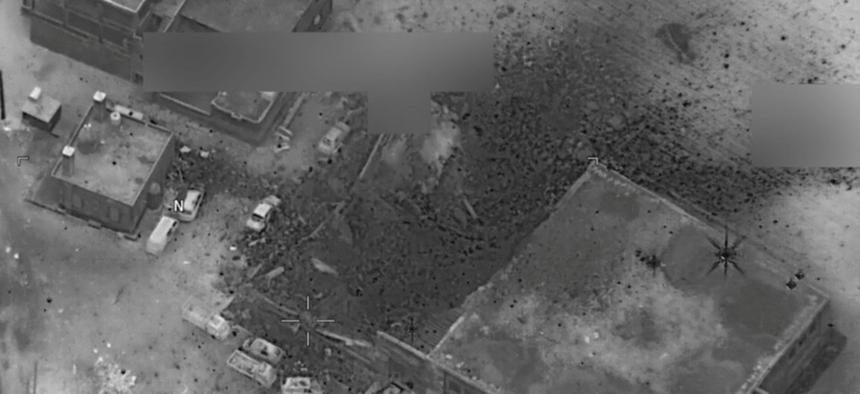
A photo of a March 16 airstrike by U.S. forces on a building that U.S. officials said was the scene of an al-Qaeda meeting. U.S. Navy
The US Was Already Fighting in Syria
It has targeted ISIS and other terrorist groups, not the Assad regime—though that might change soon.
President Trump’s remarks that he’s “changed his mind” about Syria and its leader, Bashar al-Assad, after this week’s deadly chemical attack, has raised speculation the U.S. might be considering military action in Syria.
CNN reported that Trump told some congressional lawmakers he was considering military action. Reuters cited an anonymous senior administration official who said that the military option remained on the table in Syria. Notwithstanding the fact the United States, as a matter of policy, retains the right to use force against an adversary, the remarks gloss over an important point about U.S. military operations in Syria: U.S. forces have carried out more than 7,000 airstrikes in the country since 2014, as well as special-operations forces, against the Islamic State and other terrorist groups. The operations are said to have resulted in ISIS losing up to 25 percent of its territory in both Syria and neighboring Iraq. The strikes have hit ISIS fighters, as well as its oil infrastructure, a key source of revenue that has since dried up.
As the Syrian civil war raged on, the Obama administration was faced with a conundrum: Attack Assad, whose actions against his people, including the use of chemical weapons, had resulted in a massive humanitarian crisis, and embolden ISIS, the strongest anti-Assad fighting force in Syria; or attack ISIS, which murdered, raped, and pillaged its way to power in large parts of Iraq and Syria while enforcing its strict version of sharia law, and bolster Assad. The Obama White House chose the latter, ensuring that Assad, who also had the support of the Russian military, Iran, and Hezbollah, the Shia militia from Lebanon, is more firmly in control of his country now than at any point since the civil war began more than six years ago.
The action by the United States and its allies from more than a dozen countries against ISIS in Syria has not been without costs. A Jordanian pilot whose plane crashed in ISIS-held territory was burned alive by the terrorist group. At least 300 civilians have been killed in coalition airstrikes in Syria, as well, according to Amnesty International, and 62 Syrian troops the U.S. said were mistakenly killed. Nor is the U.S. action in Syria confined to airstrikes. Last month, 400 Marines and Army Rangers arrived in Syria, joining the approximately 500 U.S. military personnel already in the country. John Dorrian, a spokesman for the U.S.-led coalition, said they would work with their local partners in the Syrian Democratic Forces, which includes Kurdish fighters, and the Syrian Arab Coalition in the fight against ISIS to recapture Raqqa, the group’s de-facto capital. Dorrian said U.S. military personnel would not have a front-line role. Separately, Lieutenant General Joseph Anderson, the U.S. Army’s deputy chief of staff, told the Fayetteville Observer the United States was planning to send more than 2,500 paratroopers to Kuwait, where they will “be postured there to do all things Mosul, Raqqa, [and] all in between.”
Trump’s own views toward military action against Assad appear to have evolved. Even before he ran for president, Trump urged Obama not to strike the Syrian leader. During the campaign, he said fighting Assad and ISIS at the same time was “madness and idiocy.” But Trump’s words on Assad after the chemical attack give him little room to maneuver—even though they seem vague. (“He’s there, and I guess he’s running things, so I guess something should happen,” he told reporters on Air Force One.) But military action against Assad could be complicated by the Russian military presence already there on behalf of Assad, and though Russian President Vladimir Putin said Thursday his support for Assad isn’t unconditional, Moscow has been quick to reject the idea that Assad was behind this week’s chemical-weapons attack.
But with news reports Thursday suggesting the Pentagon is developing military options for President Trump in response to Tuesday’s deadly chemical attack, which the White House blamed on Assad, and Secretary of State Rex Tillerson saying “there would be no role for [Assad] to govern the Syrian people”—an about-face from his remarks just days earlier—it appears as if the nearly three-year-old U.S. operation in Syria could soon expand.



